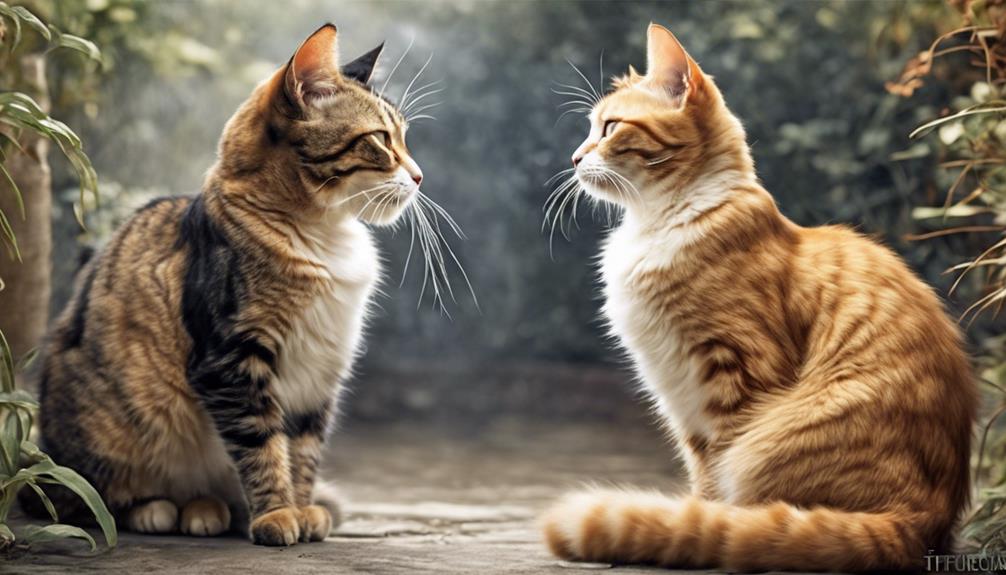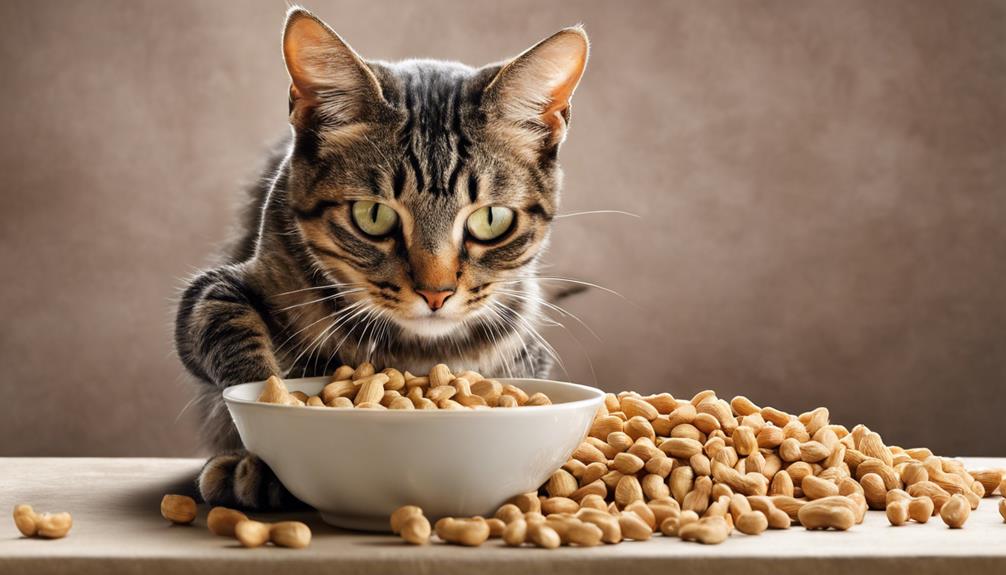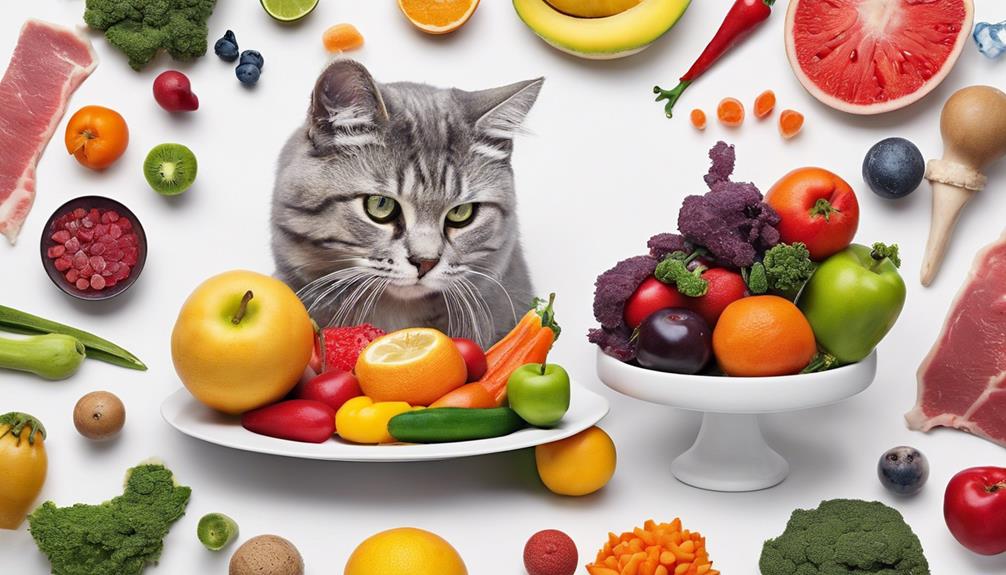Cats greet each other through scent communication by rubbing, scratching, and urine marking to establish territories and social hierarchies. Mutual grooming strengthens bonds, reduces stress, and maintains hierarchy. Play-fighting is a non-aggressive way for cats to communicate and practice hunting skills. Vocalizations like meows and purrs express feelings, while cheek rubbing and headbutting show trust and affection. Whiskers, tail, and ear positions play key roles in non-verbal communication, signaling mood and social dynamics. Understanding these cues helps decipher cat interactions and relationships. Greeting behaviors reveal intricate ways cats build connections with one another.
Key Takeaways
- Cats greet each other through scent exchange via cheek rubbing and nose touches.
- Non-verbal cues like tail greetings, chin rubbing, and slow blinking facilitate greeting.
- Social bonding is reinforced through playful interactions like play-fighting and chasing.
- Whisker movements and posture expressions convey mood, respect, and readiness for interaction.
- Understanding body language, vocalizations, and scent communication aids in interpreting cat greetings.
Scent Marking for Territory
When cats meet, they engage in scent marking for territory to establish boundaries and communicate with one another. Scent plays a crucial role in a cat's social interactions, helping them navigate the complex world of feline communication.
By rubbing against objects, scratching, and sometimes even spraying urine, cats leave behind pheromones that convey essential information about their presence and status. This scent marking not only defines their territory but also serves as a form of communication with other cats in the area.
Through these olfactory cues, cats create a familiar environment that aids in identifying group members and establishing social hierarchies. Understanding the significance of scent marking provides valuable insights into how cats greet each other and interact within their communities.
Mutual Grooming Behavior
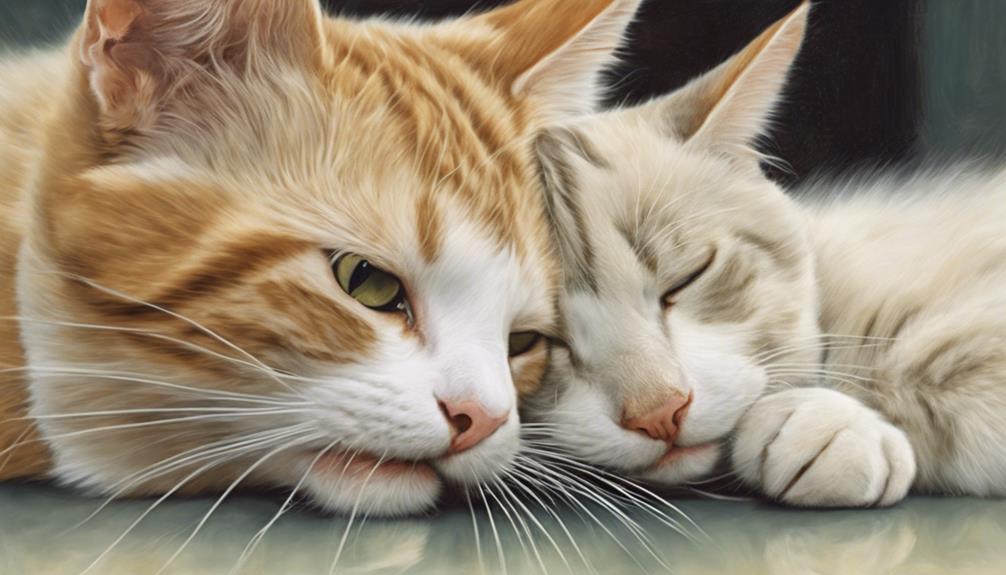
Mutual grooming behavior in cats serves multiple purposes, such as bonding, maintaining social hierarchy, and reducing stress. Cats engage in grooming rituals to strengthen their relationships with other felines, establish their place within the group, and find comfort in moments of tension.
This grooming exchange not only keeps their fur clean and well-kept but also fosters a sense of community and security within their social circle.
Grooming for Bonding
Engaging in mutual grooming behavior, also known as allogrooming, is a common and essential way for cats to bond and strengthen their social connections. Cats groom each other's head, neck, and back areas, showing trust and affection.
This grooming ritual not only helps cats stay clean and regulate body temperature but also reduces stress levels within their social group. When cats engage in allogrooming, it signifies a close and friendly relationship, fostering a sense of security and camaraderie.
Through grooming, cats establish hierarchy within their group and promote social cohesion. Witnessing cats groom each other is a heartwarming display of their social nature, highlighting the importance of grooming for bonding in the feline world.
Social Hierarchy Maintenance
Maintaining social hierarchy among cats is facilitated through the grooming behavior they exhibit towards one another. Mutual grooming plays a crucial role in establishing and reinforcing social hierarchies within a group of cats. This behavior fosters bonding, trust, and cohesion, enhancing the relationships among individuals. Here is a breakdown of how mutual grooming contributes to social hierarchies:
| Mutual Grooming in Cats | |
|---|---|
| Purpose | Establishing social hierarchies |
| Benefits | Bonding and trust |
| Outcome | Strengthened group relationships |
Through mutual grooming, cats not only maintain their social order but also promote harmony and reduce tension within their group. This natural behavior showcases the intricate ways in which cats communicate and interact, ultimately strengthening the bonds that tie them together.
Stress Reduction Technique
To understand the significance of mutual grooming behavior in cats as a stress reduction technique, it's important to recognize its role in fostering social bonds and alleviating tension within feline groups. Allogrooming, or mutual grooming, isn't just about cleanliness; it's a way for cats to show care and affection for each other.
When cats engage in reciprocal grooming sessions, they exchange scents, reinforce social hierarchies, and promote group cohesion. This behavior is especially common among social cats and can be an essential tool in maintaining harmony in multi-cat households.
Play-Fighting as a Greeting
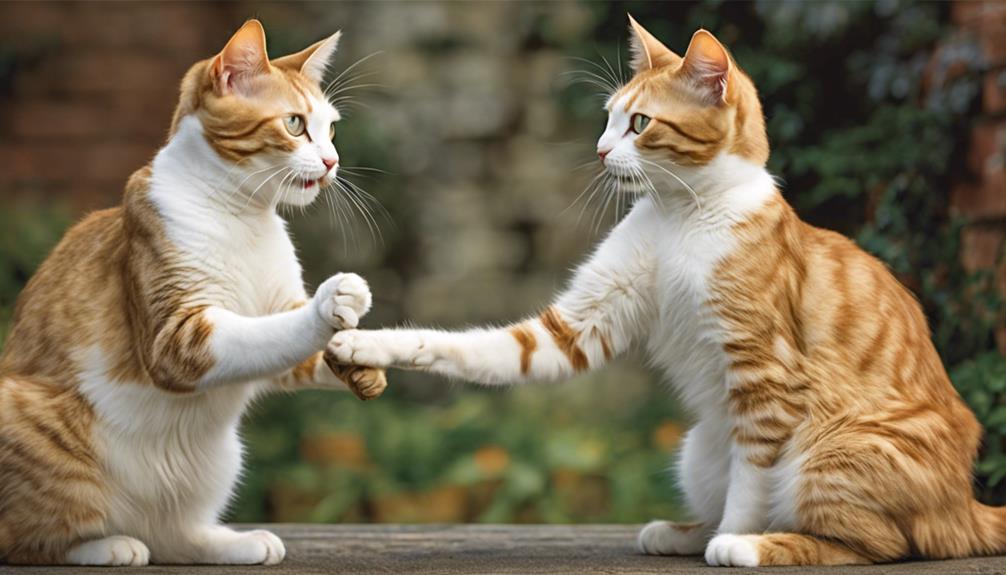
When cats greet each other, they often engage in play-fighting as a way to establish social bonds and communicate non-aggressively. Play-fighting is a pivotal behavior seen among cats, especially between familiar individuals. It involves playful interactions like chasing, pouncing, wrestling, and mock aggression, all done without causing harm. Through play-fighting, cats not only practice their hunting skills but also use it as a means to communicate and reinforce social hierarchies within their group or between individuals.
Understanding play-fighting in cats is vital as it helps to differentiate between playful interactions and true aggression in their social dynamics. By observing their body language during play-fighting, such as relaxed postures, gentle movements, and non-threatening vocalizations, we can appreciate the role it plays in their social interactions. So next time you see your cats engaging in a playful tussle, know that it's their way of bonding and communicating in a non-aggressive manner.
Vocalizations for Communication
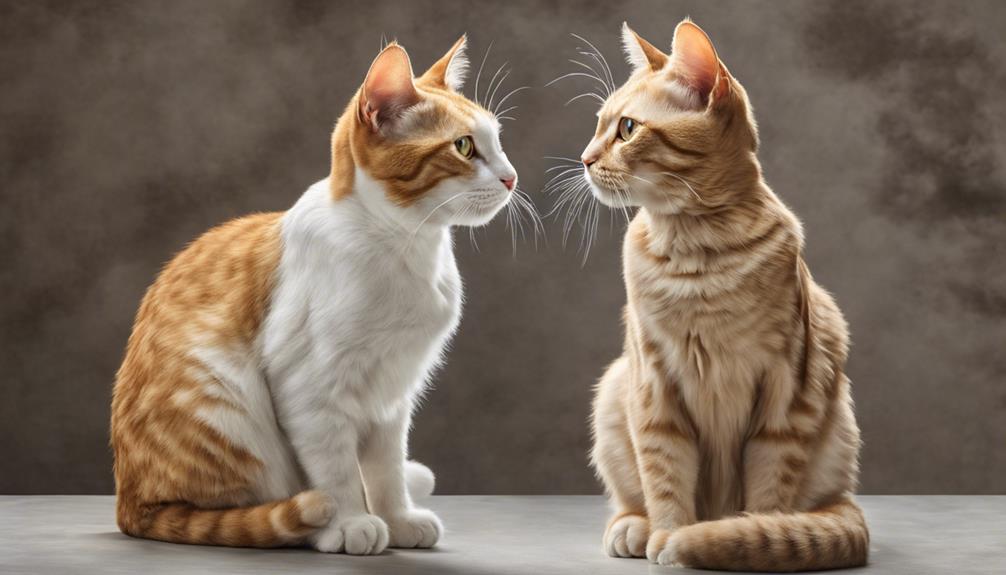
Cats utilize a variety of vocalizations to communicate with each other, including trill-like noises that serve as friendly greetings. When cats communicate, they use different sounds to convey their feelings and intentions. Here's a peek into the feline language through vocalizations:
| Vocalization | Description | Example Usage |
|---|---|---|
| Meow | Reserved for humans or as a request for food | "Meow" when hungry or seeking attention |
| Purr | Signifies contentment or self-soothing | Purring while being petted or resting |
| Growl | Indicates fear, pain, or discomfort | Growling when feeling threatened |
| Hiss | Shows aggression or fear | Hissing when feeling cornered or scared |
| Chirp | Indicates excitement, especially during playful times | Chirping while playing or hunting |
Understanding these vocalizations can help decipher what your cat is trying to express, enhancing the bond between you and your feline friend.
Cheek Rubbing Significance
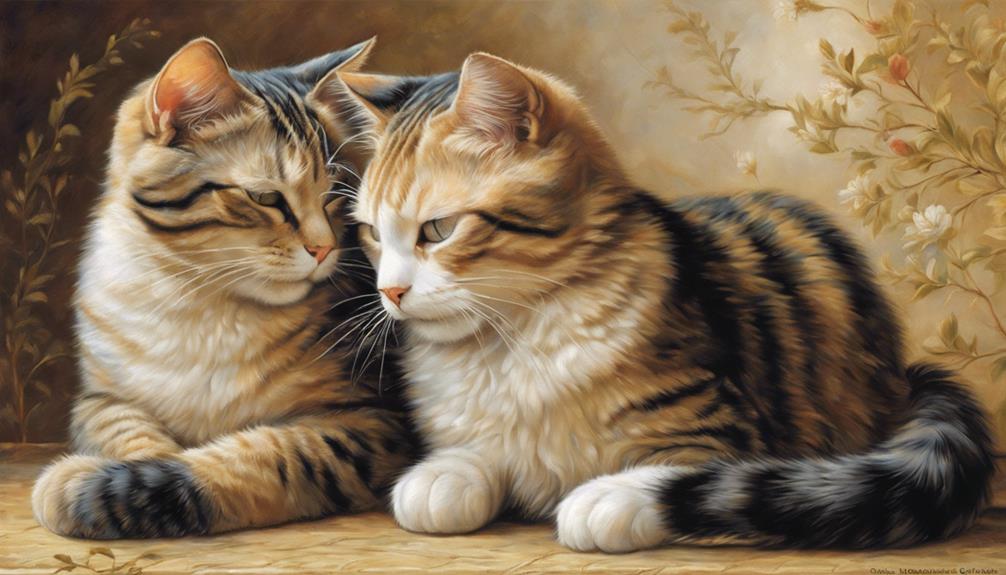
Cheek rubbing among cats serves as a form of communication, allowing them to exchange information through scent.
This behavior also helps cats mark their territory, indicating ownership and boundaries.
Additionally, cheek rubbing is a social gesture that strengthens bonds between cats and promotes harmony within their groups.
Cheek Rubbing Communication
Engaging in cheek rubbing is a natural behavior for cats that facilitates communication through the transfer of scent from the glands located on their cheeks. Cheek rubbing serves as a way for cats to mark objects, individuals, or other felines with their unique scent, creating a sense of comfort, familiarity, and social bonding. This friendly gesture helps cats recognize each other and promotes group cohesion. Reciprocal cheek rubbing is common among cats, as it allows them to establish a shared scent profile within their social group.
| Cheek Rubbing Communication | Facts | Significance |
|---|---|---|
| Natural behavior | Facilitates communication through scent transfer | Creates comfort and familiarity |
| Marking behavior | Helps recognize individuals and establish group cohesion | Promotes social bonding and group identity |
| Reciprocal interaction | Establishes shared scent profile within social groups | Strengthens bonds and fosters group unity |
Territory Marking Behavior
As a natural behavior for felines, the act of cheek rubbing serves as a significant form of territory marking and social bonding. When cats rub their cheeks against each other or objects, they aren't only leaving behind their scent but also establishing boundaries within their environment. This territorial marking helps them feel secure and familiar in their surroundings, creating a sense of ownership and belonging.
Additionally, cheek rubbing is a social behavior that goes beyond marking territory; it's a way for cats to show affection and strengthen relationships with other felines and even their human companions. Understanding the importance of cheek rubbing in cat interactions can provide insights into their social dynamics and the depth of their connections with others.
Social Bonding Gesture
Understanding the significance of cheek rubbing among cats sheds light on their social bonding behaviors and the depth of their connections with others. When a cat engages in cheek rubbing, they aren't just marking territory but also expressing familiarity and affection.
This seemingly simple gesture is rich in meaning, as it allows cats to share their unique scent profile with others in their social group. By releasing pheromones from the scent glands on their cheeks, cats establish a communal scent that promotes cohesion and recognition within their social circle.
Cheek rubbing is a non-threatening way for cats to communicate their bond with one another, creating a harmonious environment and indicating positive relationships. So, the next time you witness cats engaging in this behavior, know that it signifies a strong social connection between them.
Importance of Slow Blinking
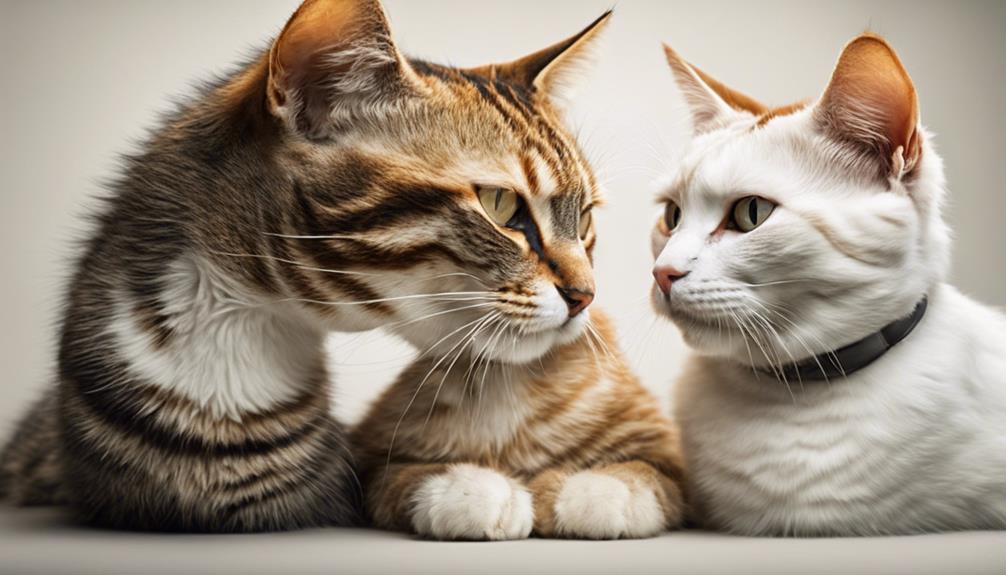
When cats engage in slow blinking, they're expressing trust and affection towards each other. This gentle eye communication serves as a non-threatening way for cats to communicate their feelings, creating a sense of safety and closeness.
By reciprocating slow blinks, cats can reduce tension and establish a stronger bond with one another. It's a calming signal that indicates relaxation and comfort within their social interactions.
Slow blinking not only conveys a message of trust but also helps in building friendships among cats. This subtle yet powerful gesture plays a significant role in their social dynamics, showing the depth of their connections and enhancing their social cohesion.
Understanding Body Language Cues
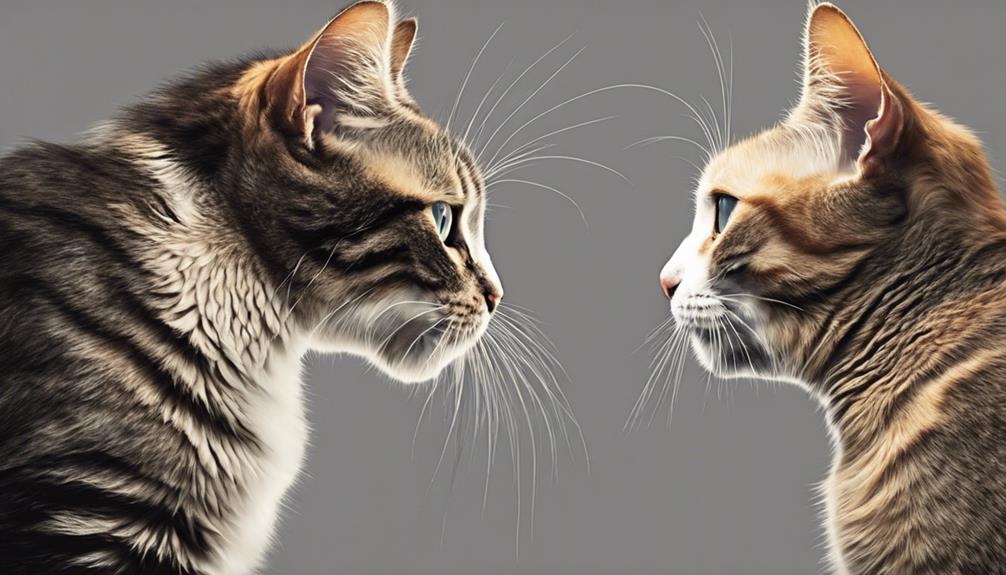
Touching noses, foreheads, or cheeks is a common friendly gesture through which cats greet each other. Understanding body language cues in cat language is essential for interpreting their interactions. When cats greet each other, they're exchanging scents, creating a bond through their unique odors. This intimate act helps them recognize each other and build familiarity.
To better understand cat language, pay attention to the following cues:
- Nose Touches: Cats often touch noses as a way of exchanging scents and showing affection. This gesture helps in creating a sense of closeness between feline friends.
- Tail Hooks: Observing how cats hook their tails when they greet each other can give insight into their mood and intentions. A relaxed tail hook indicates a friendly encounter.
- Rubbing Against Each Other: Cats may rub against each other to share their scents and mark their territory. This behavior shows trust and camaraderie among feline companions.
Tail Communication Signals
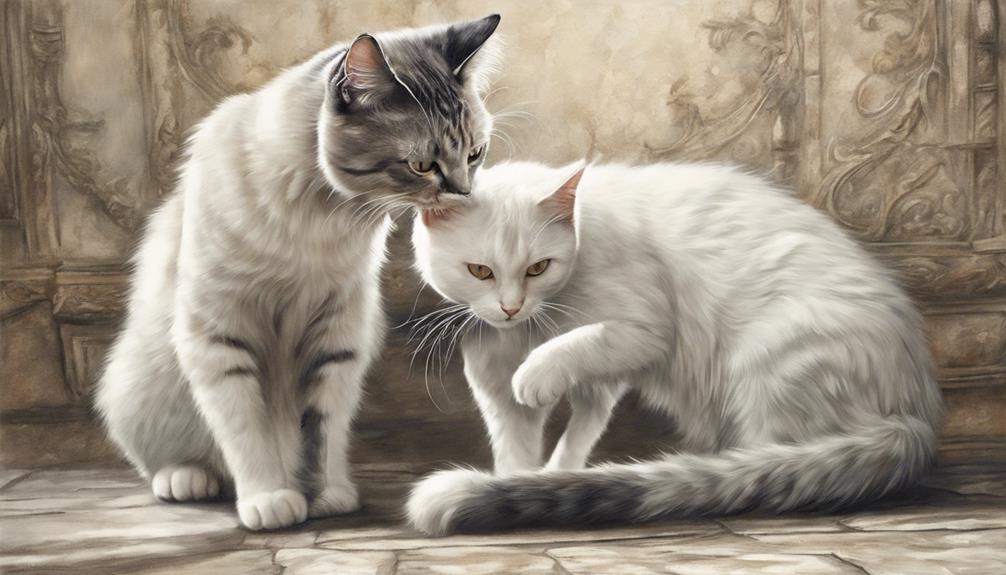
When cats greet each other, their tail positions can convey a variety of meanings, from friendliness to caution.
Tail flicking behavior is a common way for cats to communicate their excitement or agitation.
Understanding these subtle tail communication signals can help us interpret our feline friends' emotions more accurately.
Tail Position Meanings
Understanding the various tail positions in cats can provide valuable insights into their mood and intentions during social interactions. When observing a cat's tail, paying attention to its position is crucial, as it communicates a lot about how the cat is feeling. Here are some key meanings behind different tail positions:
- A high tail held straight up signifies confidence and friendliness.
- A tail curved like a question mark indicates curiosity and a non-threatening attitude.
- Tucking the tail or wrapping it around the body may suggest uncertainty or anxiety.
Tail Flicking Behavior
Tail flicking behavior in cats serves as an essential form of communication, revealing insights into their emotional state and intentions. When a cat flicks its tail rapidly, it may indicate excitement or agitation, showing a readiness to play or engage.
On the other hand, slow tail flicks can signal curiosity or interest in something intriguing. By observing a cat's tail flicking combined with other body language cues, such as ear position and vocalizations, we can better understand their mood and respond appropriately.
This understanding of tail communication signals not only deepens our bond with our feline companions but also helps to enhance our interactions, leading to more fulfilling and enjoyable moments together.
Ear Position Meanings
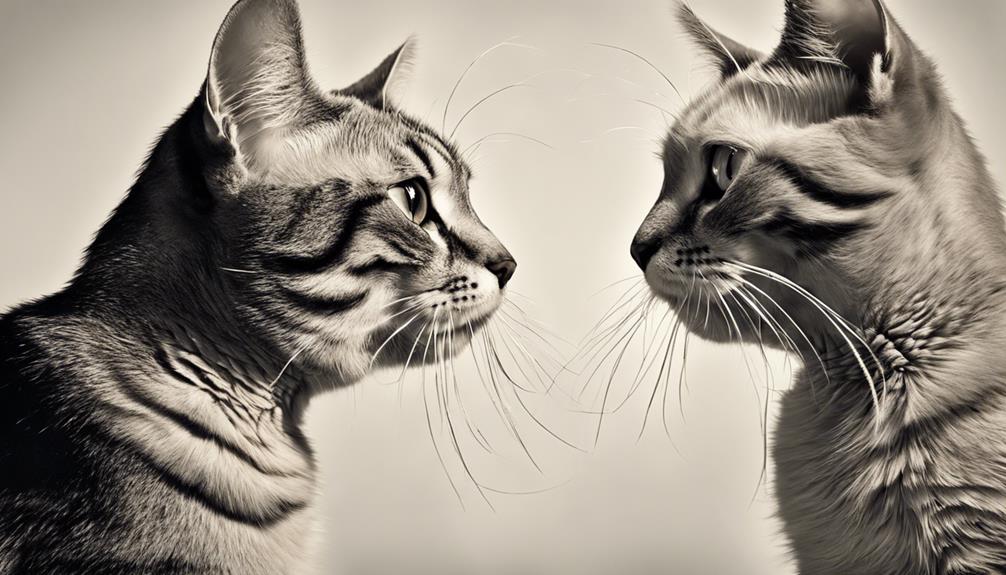
In the domain of feline communication, the positioning of ears plays a significant role in conveying messages between cats. When observing cats engaging in cat-to-cat interactions, decoding the meanings behind their ear positions is vital for understanding their mood and intentions.
Here are some key points to keep in mind:
- Forward-Facing Ears: Indicate friendliness and relaxation, showing trust and comfort as cats approach each other with their ears held high and forward.
- Flattened or Pinned Back Ears: Signal fear, aggression, or defensiveness, suggesting a tense or potentially hostile interaction between cats.
- Valuable Insights: The ear positions of cats provide valuable insights into their emotions and intentions, helping us decipher their communication and interactions during greetings.
Purring as a Form of Greeting
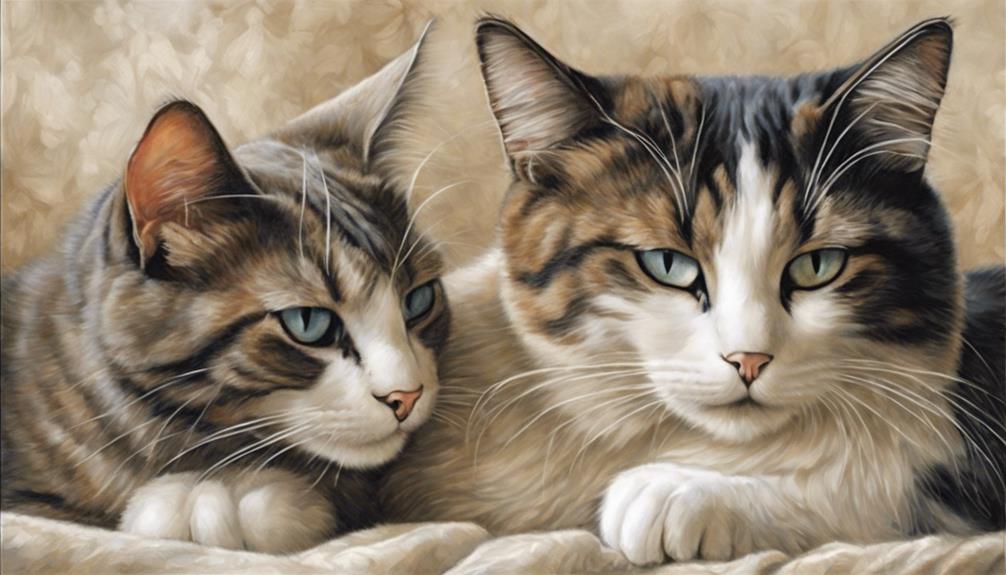
When cats greet each other, purring softly serves as a crucial and welcoming form of interaction. Purring is a key aspect of feline communication during social encounters. It helps cats establish positive connections, creating a calming atmosphere that sets the tone for their interaction. Through purring, cats convey their intentions of non-aggression and their desire for social engagement. This gentle sound is a means of mutual recognition, bonding, and communication within their social hierarchy.
The act of purring as a form of greeting is deeply rooted in the instinctual behavior of cats. It plays an essential role in their social interactions, allowing them to express their friendliness and openness to engage with others. When cats approach each other and engage in purring, it signifies a willingness to interact harmoniously and build rapport. Purring serves as a universal language among cats, facilitating smooth and amicable greetings that promote positive social relationships.
Paw Touches and Kneading
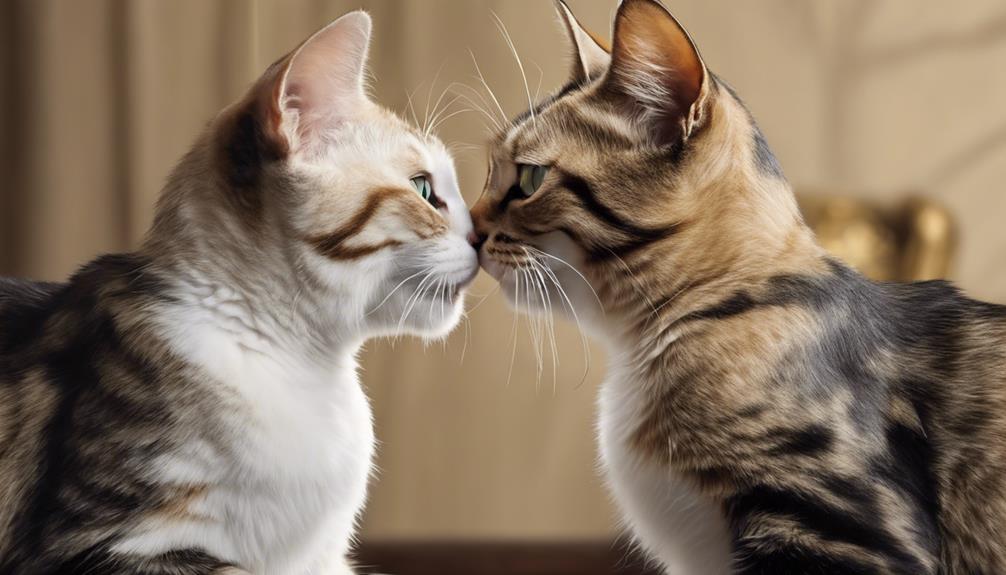
Often, cats express friendship and trust through paw touches and kneading, behaviors that promote social bonding and affection. Cats rub their paws against each other as a way of exchanging scents, creating a familiar and comforting environment. Kneading, where cats rhythmically push their paws in and out, is a gesture of comfort and affection, reminiscent of their kittenhood when they nursed for sustenance and security. This behavior not only helps cats bond with each other but also serves as a self-soothing mechanism, providing them with a sense of relaxation and contentment.
The gentle interactions through paw touches and kneading contribute significantly to the social harmony and communication among cats. It's a way for them to establish connections, show affection, and build trust within their group. These behaviors play a vital role in maintaining healthy relationships and promoting a sense of security and well-being among feline companions.
Headbutting Behavior
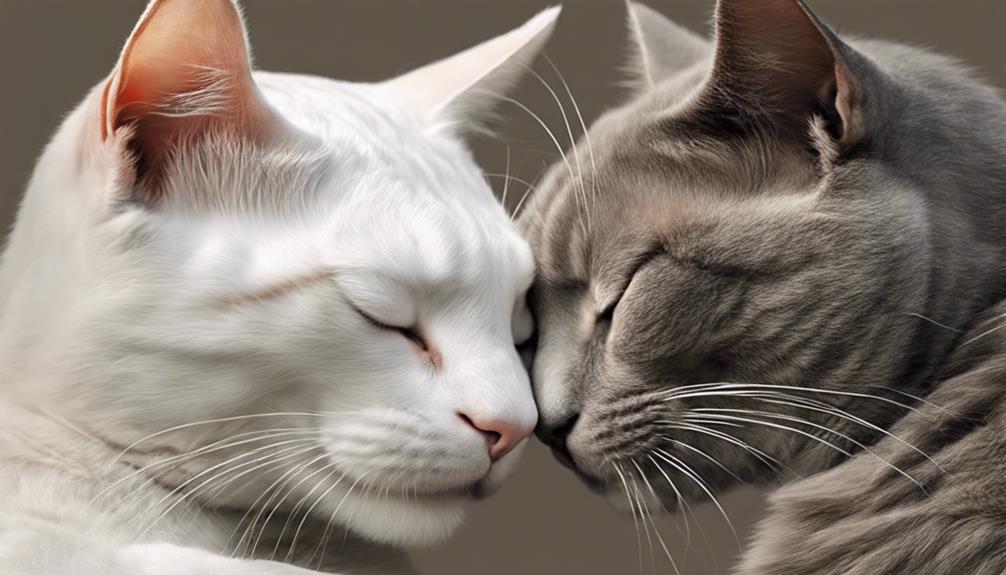
Gently bumping heads is a common friendly greeting gesture among cats, facilitating scent exchange and social bonding. When cats engage in headbutting behavior, they are not just sharing a sweet moment; they are also exchanging scents that hold significant information about their identity and emotions. To give you a better understanding of the importance of headbutting in cat communication, let's explore the key aspects of this behavior:
| Key Aspects of Headbutting Behavior | ||
|---|---|---|
| Friendly Greeting Gesture | Scent Exchange | Social Bonding |
| Cats use headbutting to greet each other and humans in a non-threatening manner. | By rubbing their heads together, cats exchange scents that convey important information. | Headbutting fosters familiarity and strengthens social bonds among cats and their human companions. |
Next time your feline friend gently bumps their head against you, remember that it's not just a simple gesture; it's their way of saying, 'I trust you, and I feel connected to you.'
The Role of Whisker Movements
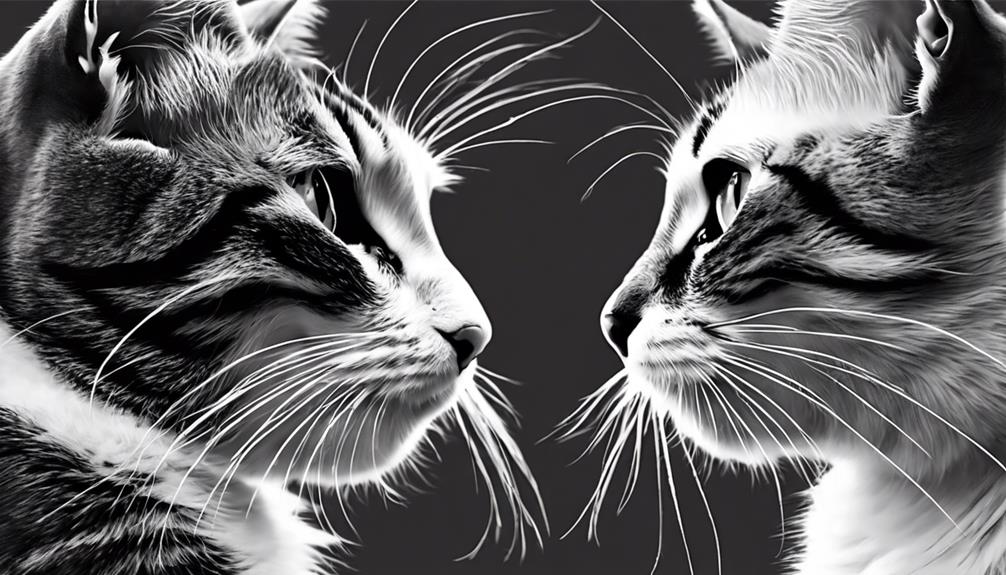
Whisker movements in cats are like their social language; they convey a lot without a single meow.
These subtle movements help cats establish social hierarchy, boundaries, and comfort levels during interactions.
Whisker Signals in Communication
In cat communication, the role of whisker movements is vital, conveying essential cues about emotional states and intentions.
- Whiskers act as a sensory radar system, helping cats navigate and assess their surroundings.
- Forward-pointing whiskers indicate curiosity or excitement, while flattened whiskers signal fear or aggression.
- Cats use their whiskers to measure openings and determine if they can fit through spaces.
Understanding these whisker signals offers valuable insights into a cat's mood and behavior during social interactions. By paying attention to their whisker movements, we can better understand what our feline friends are feeling and how they're likely to react in different situations.
Social Hierarchy Cues
Assertive cats typically display relaxed whiskers, signaling their confidence and social dominance within a group. Cats use whisker movements as a form of non-verbal communication to establish their position in the social hierarchy during cat-to-cat greetings.
When a cat's whiskers are pushed forward, it indicates their readiness to engage in social interactions or play, showing a more approachable demeanor. On the other hand, cats with whiskers pulled back may be signaling a more defensive or submissive posture.
Non-Verbal Interaction Cues
Observing how cats position their whiskers provides valuable insights into their social dynamics and communication patterns during greetings.
- Whisker movements in cats play an essential role in non-verbal communication during greetings.
- Cats use whiskers to assess their surroundings, detect changes in the environment, and gauge distances.
- Whisker positioning can indicate a cat's mood, level of alertness, and intention during interactions.
When cats angle their whiskers forward during a greeting, it's a sign of interest and engagement. Understanding these subtle whisker movements helps decipher their social interactions. It's fascinating how such small details can convey so much in their non-verbal communication.
Posture Expressions in Greetings
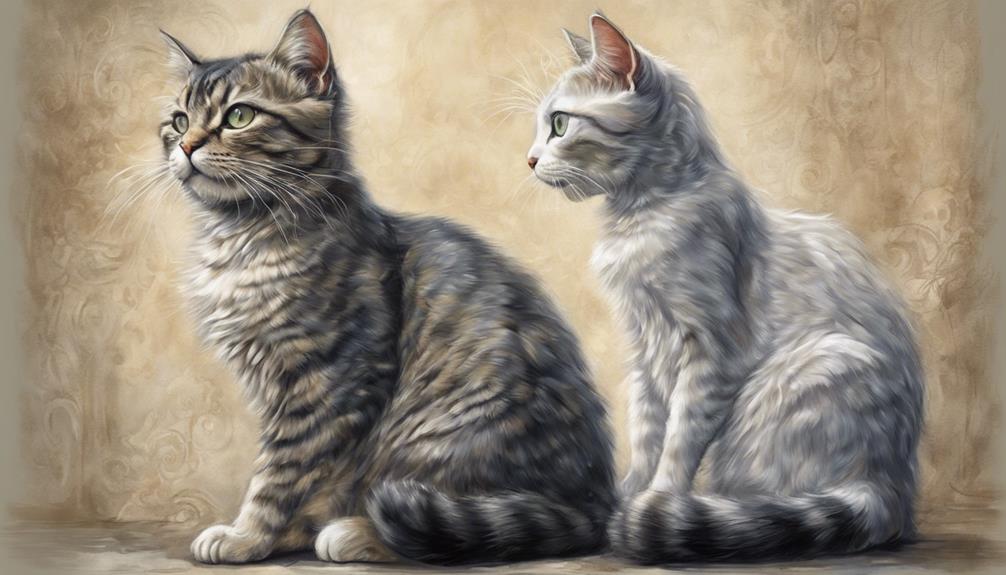
When cats greet each other, their posture expressions play a crucial role in communicating their intentions and emotions. Touching noses is a common way for cats to greet each other, signaling friendly interaction and mutual respect. This gentle gesture allows them to exchange chemical cues, deepening their bond and understanding of one another.
Tail greetings, where cats hook their tails together, demonstrate companionship and camaraderie among feline friends. These gestures are essential in establishing connections and maintaining social harmony within the cat community.
In addition to nose touches and tail greetings, cats may also engage in forehead touches to express trust and affection. Cheek rubbing is another prevalent greeting gesture used by cats to exchange scents and establish familiarity. Chin rubbing, on the other hand, serves as a form of social bonding and communication, enhancing their social connections.
Social Hierarchy Establishment
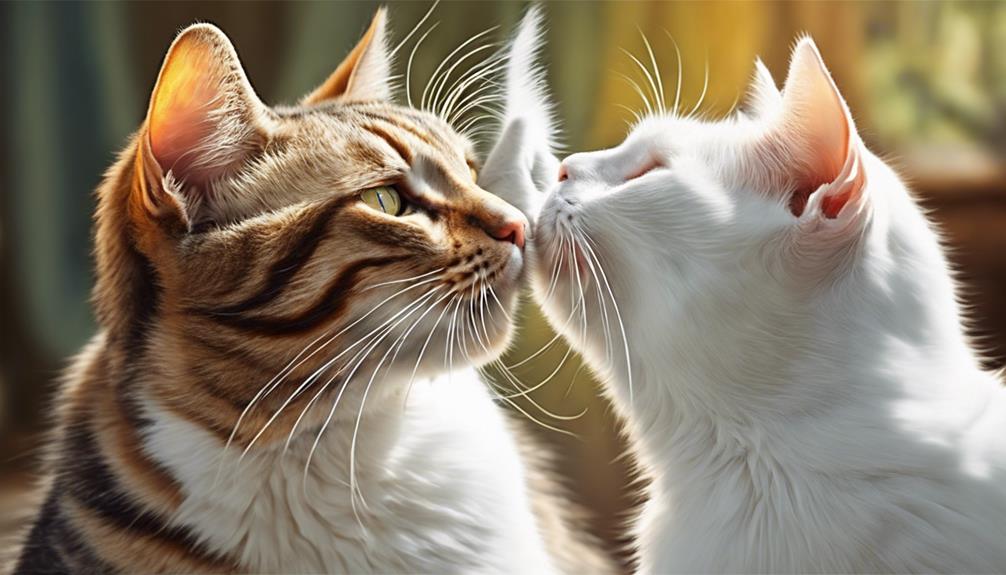
Establishing social hierarchy among cats involves interpreting body language cues such as tail positioning and ear movement to understand their roles within the feline community. Dominant cats may assert their status through behaviors like head butting and rubbing, while submissive cats display deference by avoiding direct eye contact and yielding space to dominant cats. Additionally, social grooming and mutual scent marking play essential roles in reinforcing social bonds and hierarchy within cat groups.
Understanding these body language cues is vital for cat owners to create a harmonious environment for their feline companions. By recognizing these signals, conflicts can be minimized, and interactions among cats can be more peaceful. Observing how dominant and submissive cats interact can provide valuable insights into their social structure and dynamics. Encouraging positive social behaviors and providing adequate resources can help maintain a healthy social hierarchy among cats in multi-cat households.
Frequently Asked Questions
How Do Cats Greet Other Cats?
We greet other cats by touching noses, mutual grooming, tail hooking, and scent exchange. These gestures show affection, bond us together, and establish trust. Head butts and cheek rubs are also common, indicating camaraderie and friendship among feline companions.
How Do Cats Show Affection to Each Other?
We show affection by grooming heads and necks, intertwining tails, and engaging in mutual head rubbing. Play fighting and chasing help us bond. Sharing resting spaces and sleeping close build trust and belonging among us.
What Do Cats Say When They Talk to Each Other?
When cats talk to each other, they use a variety of vocalizations and body language to communicate. They convey feelings like friendliness, fear, or contentment through trill-like noises, purring, growling, or hissing.
What Do Cats Do When They Say Hello?
When we say hello, we touch noses, rub cheeks, and share warmth. These gestures create bonds, trust, and harmony. We express affection non-verbally, establishing connections that speak louder than words, reinforcing our social ties with each other.
Do Cats Use Greeting Behavior When Yowling at Night?
When dealing with cat yowling at night, it’s important to understand their behavior. While it may seem like a greeting, cats often yowl for various reasons such as attention, mating, or territorial issues. A stepbystep solution for cat yowling involves assessing the underlying cause and providing appropriate care or training.
Conclusion
To sum up, cats have a unique way of greeting each other through various behaviors such as scent marking, mutual grooming, play-fighting, vocalizations, cheek rubbing, headbutting, whisker movements, and posture expressions. These interactions help establish social hierarchy and communication among felines.
Just like humans have their own customs and gestures when greeting each other, cats have their own intricate ways of saying hello. Understanding these behaviors can give us a glimpse into the fascinating world of cat communication.
